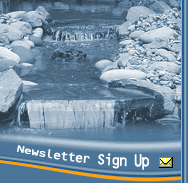 |

Downs By The Pond
86663 Bailey Hill Road
Eugene, OR 97405
Phone: 541-521-7389
Email
Us
|
|
|
Water Containment
- Preformed vs. Liner vs. Concrete
- Measuring for liner
- Underlayment
- Lining
1. Preformed vs. Liner
vs. Concrete Top
Preformed ponds tend to be shallow, under 24, and this makes any
fish easy targets for predators. As small preformed ponds are usually
much less expensive than larger preformed ponds, people often settle
for a pond smaller than they wanted. Careful excavation and backfilling
is critical when installing preformed ponds. If not properly installed,
preformed ponds will warp and any unevenness will be highly noticeable.
Proper care needs to be used in supporting any rock which rim the
pond, as the weight of this rock can often cause the plastic to warp.
A flexible liner allows for flexibility and creativity of design.
A more natural pond can be created, and greater depth and size are
possible. Liners also tend to be more economical, especially in medium
to large ponds. Since the water will always be level, any adjustments
for existing contours of the land can be done before rocks are placed.
Fish and plants can be added sooner than if concrete is used.
PVC liner is usually 30 mil or less in thickness. It does not have
much flexibility, causing it to be harder to install. It may become
brittle with age, and is very difficult to re-use, should you desire
to change the shape of your pond. A shorter life expectancy is common,
and the usually textured surface makes it hard to repair.
EPDM liner has a standard density (or weight) of 45 mil. It is flexible
and easy to join. Since the liner comes up to 50 feet wide, joining
is at a minimum. The liner is easy to repair using the same seaming
materials as patches, should it become torn. EPDM is long lasting,
warranted for 20 yrs., and has a 50 yr. life expectancy.
Concrete can also be used to make a pond. Special techniques are
required, and it will also need to be sealed so that lime does not
leach into the pond. Care should be given to use a liner underneath,
as settling or erosion can cause the pond to crack. It is best to
wait 6 months or more in an unsealed pond before adding fish and
plants
Bentonite is a clay product which can be rototilled into large farm
ponds. The water is usually somewhat murky, as fish swimming in the
pond will stir up silt on the bottom. We do not recommend bentonite
for most ponds. The additional work of tilling in the product will
usually be break even in cost with a good liner.
|
|
2. Measuring for liner
Top
Once the pond is dug to your satisfaction, it is time to measure
for a pond liner. Using a long tape measure (or a soft cord which
can be measured), follow the contours along the longest length and
greatest width of the pond. Use care to run the tape through the
deepest place in the pond. These measurements may be double checked
by using top measurements and depth. The formula is:
length + 2 x(depth) + 2 feet
width + 2x(depth) + 2 feet
This will give you minimum liner requirements. The same methods are
used when estimating liners for streams, waterfalls and additional
ponds.
|
|
3.Underlayment
Top
It is recommended to use some type of cushioning under the liner.
Underlayment felt, sand, or a combination of both can be used to
cushion the liner and protect against rocks & roots. Underlayment
felt is easy to work with and is sold by the lineal foot.
Sand can be used on the bottom and shelves. Use a layer 2-3 inches
deep on the bottom. This will provide cushioning when walking in
the pond. In larger pools, we usually use sand on the bottom, and
felt on the sides.
Economical alternatives that can be used are old blankets and old
carpet with the nap side down. Newspaper layers can be used, but
are hard to keep in place unless they are kept wet to prevent them
blowing away.
|
|
4.Lining
Top
Once underlayment is placed in the excavation, it is time to place
the liner in the hole. Larger pieces can be unrolled across the bottom,
and then unfolded up the sides. Many times there will be writing
on the liner. We try to put this side down. Fish can't read, and
it is distracting to the final project if any writing is left exposed.
After the liner is unfolded, smooth it as much as possible and then
begin to add water. This water will help hold the wrinkles out and
the folds flat. You may want to place rocks on the folds to keep
them in place. Do not over stretch the liner. As the water fills
the pond it will settle into the excavation.
If you will be using gravel on the bottom, do so before filling the
pond to the top. You can then rinse out the dirty water before continuing
to fill your pond.
Let the pond sit for at least 24 hours, so that the liner will settle
before trimming edges.
|
|
|
|
|











